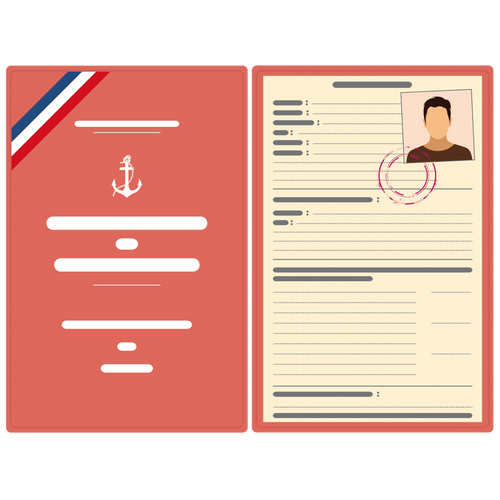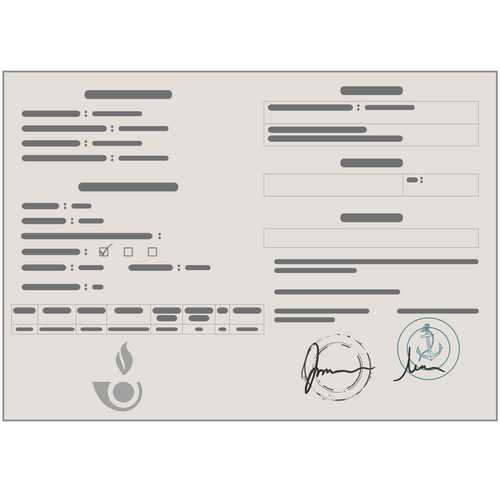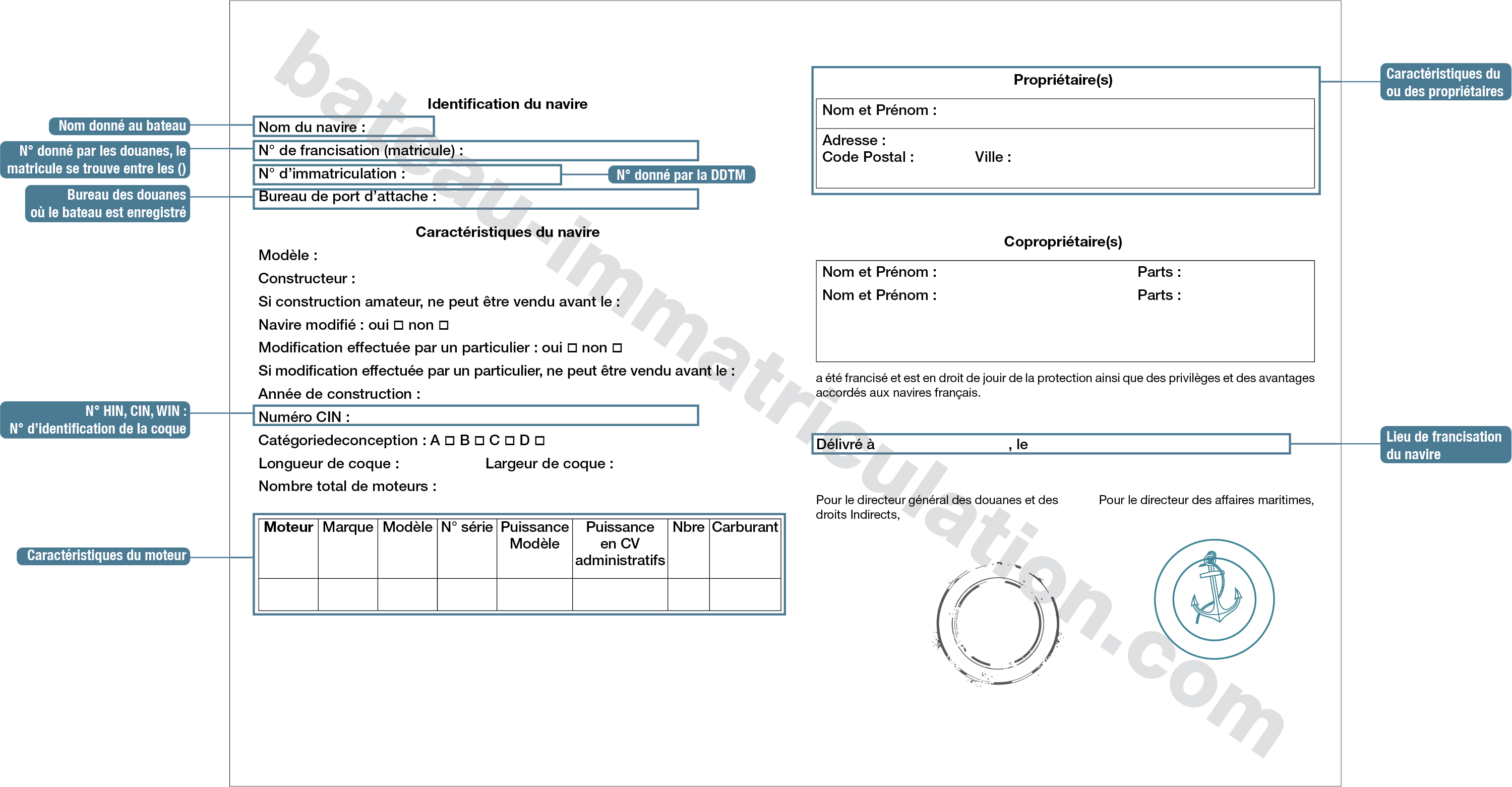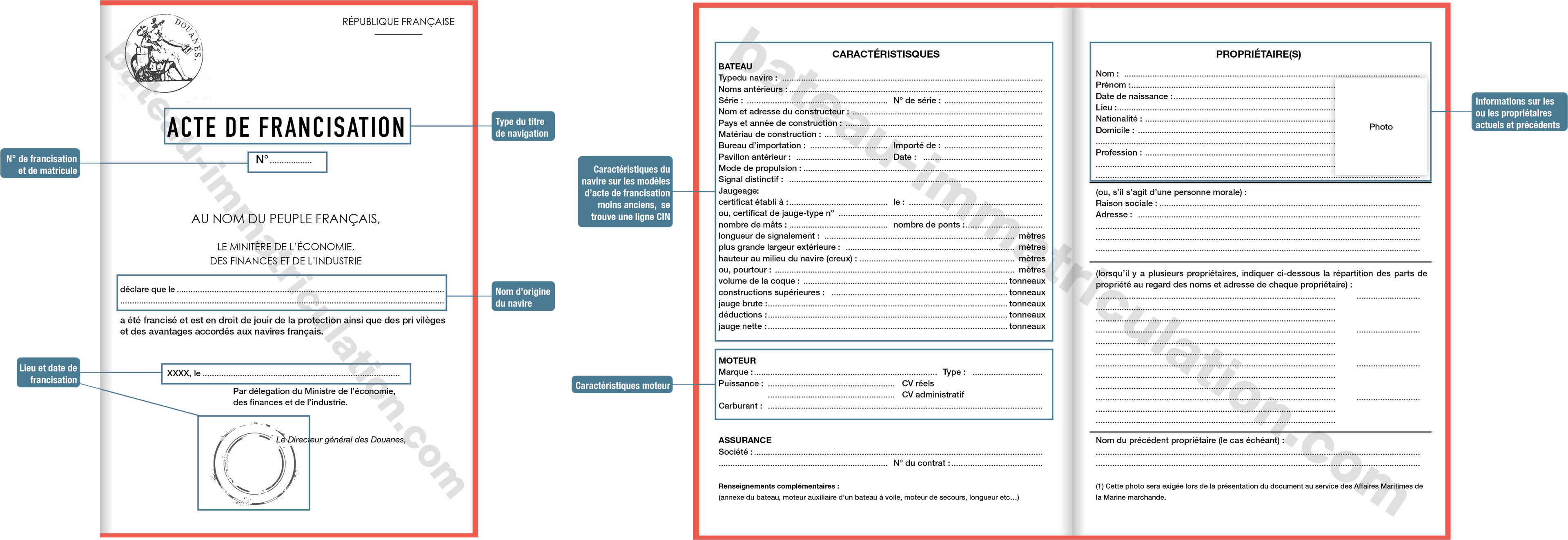Acte de francisation d’un bateau de plaisance : démarches, obligations et
cas d’exonération
Équivalent maritime de la carte grise des véhicules terrestres, l’acte de francisation est un titre de navigation comme la carte de circulation, indispensable pour naviguer en règle.
Néanmoins, ce document administratif n’est obligatoire que dans certains cas, selon le type de navire, la longueur de coque et la puissance moteur.
Pour quels bateaux de plaisance et Véhicules Nautiques à Moteur l’acte de francisation est-il obligatoire ? Qui est concerné par ce document administratif ? Comment l’obtenir ? Concernant la taxe annuelle pour les bateaux francisés, quelles sont les exonérations possibles ?
Notre service dédié aux plaisanciers et aux professionnels du nautisme vous accompagne dans vos démarches d’obtention de l’acte de francisation.
Qu’est-ce que l’acte de francisation d’un bateau ?
L’acte de francisation est une autorisation à battre pavillon français délivrée par le Services des Douanes. À ne pas confondre avec l’immatriculation d’un bateau !
Lorsque l’embarcation de plaisance est francisée, elle est soumise au droit français. Son propriétaire doit alors appliquer la réglementation en vigueur en France, autant au niveau législatif que fiscal, et s’acquitter de la Taxe annuelle sur les engins maritimes à usage personnel (TAEMUP, ex Droit Annuel de Francisation et de Navigation – DAFN), souvent appelée Taxe de francisation.
L’acte de francisation, valable toute la durée de vie du bateau tant qu’il bat pavillon français, est attaché au bateau et à son propriétaire. Tout changement (mutation de propriété, changement de situation administrative, remplacement de moteur, modification de la longueur de coque…) doit être porté à la connaissance du Bureau des Douanes.
Un nouvel acte de francisation est alors édité, remplaçant le précédent.
Le navigateur, propriétaire ou locataire, doit toujours être en possession du document administratif : lorsque le bateau est sur l’eau comme en déplacement terrestre, durant le remorquage ! L’acte de francisation doit pouvoir être présenté à tout moment à l’agent habilité au contrôle, en cas de demande.
Acte de francisation : quelles embarcations de plaisance sont concernées ?
- Tous les voiliers et bateaux à moteur avec une longueur de coque de 7 mètres et plus, et/ou disposant d’une puissance administrative égale ou supérieure à 22 CV (chevaux fiscaux) doivent être
francisés. - Tous les VNM (Véhicules Nautiques à Moteur de type jet-skis ou scooters des mers) qui disposent d’une puissance réelle supérieure à 90 kW sont également concernés par cette démarche.
Dans l’un et l’autre cas, cela s’applique aux embarcations neuves et d’occasion – peu importe l’âge du navire.
Si votre embarcation ne rentre pas dans ces critères (longueur de coque inférieure à 7 mètres, puissance inférieure...), vous devez néanmoins être en possession d’une carte de circulation et avoir immatriculé votre bateau auprès des affaires maritimes, la DDTM (Direction Départementale des Territoires et de la Mer).
La francisation est également indispensable si votre bateau de plaisance battait auparavant pavillon étranger, ou si vous comptez naviguer en eaux territoriales étrangères.
Franciser un bateau de plaisance : quelles sont les conditions requises ?
La francisation d’un bateau de plaisance, neuf ou d’occasion, concerne :
- Les embarcations construites dans l’un des pays de l’Union européenne
- Les bateaux et VNM dont les propriétaires actuels se sont acquitté des taxes et droits d’importation.
Le bateau doit également avoir passé avec succès tous les contrôles de sécurité. La DEC (Déclaration Écrite de Conformité) valide la conformité du bateau pour sa mise en service sur le marché européen.
L’embarcation doit aussi appartenir, au moins à moitié :
- Soit à un ressortissant (personne physique) d’un État membre de l’UE (France ou autre) ou d’un État en accord avec l’EEE (Espace Économique Européen), dont la résidence principale est établie en France ou y ayant fait élection de domicile
- Soit à une société (personne morale) dont le siège social est établi en France, dans un État membre de l’Union européenne ou dans un État de l’EEE.
Si ce n’est pas votre cas, nous proposons un service d’élection de domicile sur le territoire français, nous permettant de franciser votre bateau et de devenir votre référent auprès des administrations.
Francisation d’un bateau de plaisance : les étapes
Les démarches administratives
- Rassembler les documents requis
- Déposer une demande auprès du bureau des douanes
- Faire valider l’acte par la DDTM
- S’acquitter du DAFN, devenu TAEMUP
Les documents à fournir pour la francisation
- Titre de propriété ou acte de vente
- Preuve de conformité CE
- Certificat d’immatriculation
- Justificatif d’identité et de domicile
- Preuve de paiement des droits d’importation si hors UE
Comment modifier un acte de francisation ?
Nouvelle adresse, changement de moteur ou de pavillon, mutation de propriété… Vous pouvez à tout moment signaler une modification administrative sur l’acte de francisation. Il s’agit même d’une démarche obligatoire !
Vous manquez de temps ? Nous vous proposons la prise en charge complète de vos démarches administratives en cas de :

Changement de propriétaire

Changement de moteur

Changement d'adresse

Changement de pavillon
La TAEMUP : une taxe annuelle pour tous les bateaux francisés
Le DAFN, devenu TAEMUP (Taxe annuelle sur les engins maritimes à usage personnel)
Le Droit annuel de francisation et de navigation ou DAFN, devenu TAEMUP, est une taxe annuelle obligatoire pour naviguer. Celle-ci est applicable à tous les navires et VNM francisés et souvent appelée Taxe de francisation.
La taxe est calculée en fonction de la longueur de coque du bateau à voile ou à moteur, et de la puissance administrative (exprimée en chevaux administratifs) du ou des moteurs embarqués.
À savoir : pour les yachts, une taxe spécifique s’applique. N’hésitez pas à nous consulter pour en connaître le montant.
Les exonérations possibles de Taxe de francisation
La première année de taxation
Dans les mois qui suivent votre achat, lors de la première année de propriété du bateau, vous vous acquitterez de la taxe annuelle au prorata des mois durant lesquels vous aurez été en possession du bateau.
→ Si vous n’êtes propriétaire de votre bateau ou VNM qu’à partir du 1/04, vous ne payerez votre taxe de francisation que pour 9 mois, lors de l’achat, sur la période allant de début avril à fin décembre.
Ensuite, vous payerez votre TAEMUP à 100 %, recevant un avis de paiement annuel par voie postale, à l’adresse indiquée lors de l’enregistrement, chaque début d’année civile.
L’abattement de TAEMUP pour vétusté
L’abattement de TAEMUP peut être accordé, selon l’âge du bateau, si la puissance du moteur est inférieure à 100 CV administratifs. Si le montant de la taxe annuelle à payer est inférieur à 76 €, vous pourrez être exempté du paiement.
L’exonération de la taxe de francisation en cas de remplacement de moteur avec une puissance inférieure
Enfin, il peut arriver qu’un changement de moteur avec une puissance inférieure, lors de la mutation de propriété, vous exempte de la francisation. C’est le cas, avec un moteur de moins de 22 CV administratifs pour les bateaux à moteur de 7 mètres et plus, et de moins de 90 kW pour les VNM.
Si vous vous trouvez dans cette situation, signalez-le-nous : nos équipes demanderont la radiation de votre navire dans le registre, même si l’ancien propriétaire de l’embarcation vous avait transmis l’acte de francisation !
Francisation d’un bateau de plaisance : les cas particuliers
La navigation en eaux internationales
Naviguer en eaux internationales est autorisé aux navires francisés, mais uniquement si la catégorie de conception, les équipements de sécurité et les diplômes du propriétaire ou du locataire (permis de naviguer en eaux internationales) le permettent.
L’acte de francisation pour les bateaux d’occasion
Si la demande de francisation s’applique à un bateau de plaisance acheté en France ou dans l’UE, le propriétaire dispose d’un délai d’un mois à compter de la signature de l’acte de vente pour bateau de plaisance pour signaler le changement administratif et effectuer la demande de francisation du bateau.
Pour les bateaux achetés dans d’autres pays étrangers hors UE, une déclaration d’importation préalable est nécessaire pour obtenir l’acte de francisation. Les douanes peuvent également exiger une expertise de conformité du navire afin de justifier la mise sur le marché européen.
L'acte de francisation pour les bateaux étrangers
La francisation est une démarche indispensable pour les bateaux de plaisance auparavant sous pavillon étranger.
Cependant, il est possible pour un ressortissant européen ou Français, ayant élection de domicile en France, de garder le pavillon précédent : ceci, à condition de payer la même taxe annuelle TAEMUP. Il y a quelques années encore, dans ce cas précis, la taxe était appelée DAP, ou Droit de passeport.
Comment se présente un acte de francisation ?
Acte de francisation bateau de plaisance ancien modèle
Sur la couverture du carnet apparaissent les informations générales : le numéro de francisation et le matricule de l’embarcation, le nom d’origine du bateau, la date de francisation et le lieu où elle a été validée, le cachet et la signature du Bureau des Douanes.
Caractéristiques du bateau :
- Type de bateau (yacht, bateau à voile, bateau à moteur, VNM…)
- Noms antérieurs du navire
- Série et numéro de série (identifiant unique)
- Nom et adresse du constructeur
- Pays et année de construction
- Matériaux de construction
- Pavillon antérieur et importation depuis un pays étranger
- Mode de propulsion (manuel, à voile ou à moteur)
- Signes distinctifs
- Jaugeage et mesures (longueur de coque, tonnage…).
Caractéristiques du moteur :
- Marque du moteur
- Type de moteur
- Puissance du moteur exprimée en CV réels et en CV administratifs
- Type de carburant utilisé (GPL, diesel, essence).
Assurance :
- Société (nom et adresse de la compagnie d’assurance choisie)
- Numéro de contrat d’assurance.
Informations sur le propriétaire ou les copropriétaires :
- Nom
- Prénom
- Date et lieu de naissance
- Nationalité
- Adresse
- Profession.
Si le bateau appartient à une personne morale et non physique, la raison sociale et l’adresse sur le territoire français sont demandées.
S’il y a deux ou plusieurs copropriétaires, un encart est prévu pour inscrire leurs coordonnées (nom, prénom et adresse) et la répartition des parts de propriété (en %).
Enfin, le nom de l’ancien propriétaire, s’il y a lieu, doit également apparaître.
Acte de francisation nouveau modèle
Depuis le 1er janvier 2013, l’acte de francisation pour les bateaux de plaisance est un document numérique sécurisé présenté sous cette forme :
Identification du navire :
- Nom du navire
- Numéro de francisation, donné par les Douanes lors de la demande
- Numéro d’immatriculation du bateau, donné par la DDTM (les deux premières lettres correspondent au quartier d’immatriculation et sont suivies de 6 chiffres et d’une lettre-clé. S’il y a changement de propriétaire ET de port d’attache, seules les deux premières lettres seront modifiées lors de la déclaration de mutation de propriété)
- Nom et localité du Bureau des Douanes par lequel le bateau a été enregistré.
Caractéristiques du navire :
- Type de bateau (voilier, bateau à moteur, yacht, catamaran, jet-ski…)
- Modèle (nom de modèle donné par le constructeur)
- Constructeur (s’il s’agit d’une construction amateur, la date de mise en vente potentielle doit apparaître)
- Navire modifié (oui / non, modifications réalisées par un particulier ou non et si oui, date de mise en vente potentielle)
- Année de construction du bateau
- Numéro WIN (Watercraft Identification Number) : numéro d’identification de la coque du bateau qui remplace les anciens numéros HIN et CIN
- Catégorie de conception : aptitude du bateau à affronter certaines conditions de navigation (A pour haute mer, B pour le large, C pour la zone côtière et D pour les eaux protégées)
- Longueur de coque en mètres
- Largeur de coque en mètres
- Nombre total de moteurs
- Caractéristiques du ou des moteurs : marque, modèle, numéro de série (identifiant unique), puissance réelle exprimée en kW, puissance en chevaux administratifs (CV), carburant utilisé (essence, diesel, GPL).
Données des propriétaire(s) :
- Nom, prénom, adresse du ou des propriétaires
- Nom, prénom, adresse et répartition des parts (en %) des copropriétaires s’il y en a
- Nom, prénom et adresse du ou des locataires s’il y a lieu.
Un encart est prévu pour inscrire le lieu et la date de la francisation du bateau, suivi des cachets et signatures du Préfet du département et du Bureau des Douanes.



